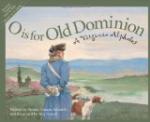At last, we were ashore and again in the “woods-way.” That was the day we got into trouble, all owing to Nautica’s passion for ancient tombstones. We were half way to Brandon when she concluded that it was not the manor-house that she wished to visit first, but the old graveyard. We stopped at the manager’s house to inquire the way. The road led inland. It soon dipped to a bridge over a little stream, where the banks were masses of honeysuckle whose fragrance followed us up the slope beyond. On a little farther was a field with a grove in the centre of it that we knew, from the directions given us, contained the cemetery.
We entered the field, and had got almost to the grove when Nautica suddenly stopped, stared, and turned pale. The Commodore’s glance followed hers; whereupon, he uttered brave words calculated to reassure the timid feminine heart, and in a voice that would have been steady enough if his knees had kept still. The bull said nothing.
Very soon, and without his moving at all, that bull was far away from us. We recognized at once that the field was properly his preserve and that we really had no right there; but we trusted that our intrusion in coming in would be atoned for by our promptness in getting out.
In the absorbing process of putting space between the bull and the houseboaters, the restlessness of the Commodore’s knees was really an advantage. They moved so fast that he was able to keep in advance of Nautica, and so be ready to protect her if another bull should appear on ahead. When he felt satisfied that he need no longer expose himself in the van (and, incidentally, that the bull in the rear had been left out of sight), he slackened his pace. We managed to get down to a walk in the course of half a mile or so; and at last approached Brandon at a quite decorous gait.
There, we learned that we had gone to the wrong cemetery anyway—to the one that had belonged to the old Brandon Church whose communion service we had seen. The Harrison burying-ground was not far from the home.
So, with members of the household, we went out across the lawn and around a corner of the garden to the family graveyard. The first Benjamin Harrison, the emigrant, who died about 1649, is not buried here. His tomb stands near the great sycamore tree in the churchyard at James Towne. However, the tombs of his descendants, owners of Brandon, are (with one exception) in this old plantation burying-ground.
[Illustration: The ancient garrison house.]
In the walk back to the house, we stopped to see what is probably the oldest, and in many respects the most interesting, building on the plantation. It is just an odd stubby brick house with a crumbling cellar-hut at one end. But family tradition says that it is one of the old garrison houses, or “defensible houses,” built in early times for protection against the Indians. It certainly looks the part, with its heavy walls, its iron doors and shutters, and the indications of former loopholes. Upon those first scattered plantations, a characteristic feature was such a strong-house or “block-house” surrounded by a stockade or “palisado” of logs.




